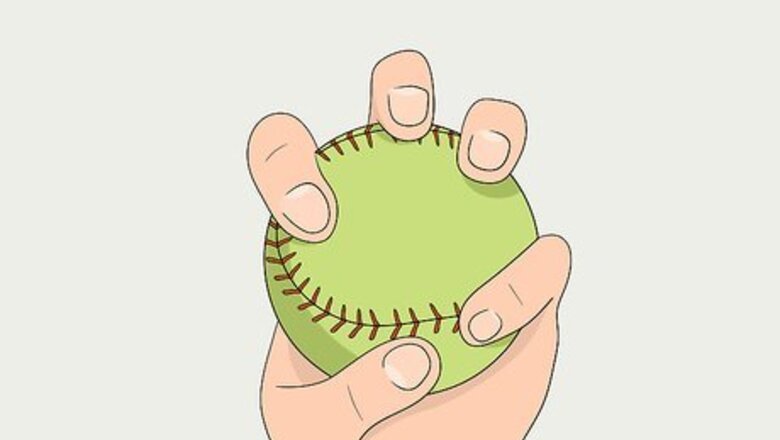
views
Setting up to Pitch
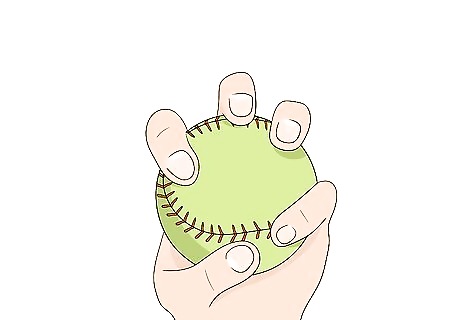
Grip the ball inside the seam curves to do a 4-seam grip. Find the “c” curves of the stitching on the softball. Then, place your four fingers inside the “c” on the top of the ball, and your thumb in the middle of the “c” on the bottom of the ball. Make sure the ball lays flush to your palm. There are no hard rules about how to grip the softball in fast-pitch softball. However, using the 4-seam grip generally allows you to pitch the ball with the most power. If it feels comfortable, you can place the pads of your fingers on the seam of the top “c” curve to help you grip the ball more securely.
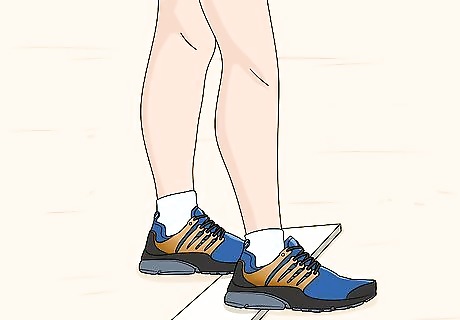
Stagger your feet over the pitcher’s plate to set up your stance. First, stand on top of the pitcher’s plate with your feet shoulder-width apart. Then, move your dominant foot (the foot that is on the same side as your throwing arm) just in front of the plate with your heel touching the front plate. Stagger your non-dominant foot (the foot on the side of your gloved hand) in back of the plate with your toes touching the plate. For example, if you’re right-handed and throw with your right hand, stand with your right foot at in front of the plate with your left foot at the back. If you’re left-handed, stand with your left foot at the front of the plate and your right toes touching the back of the plate. The pitcher’s plate in fast-pitch softball is 6 inches (15 cm) wide, so your feet will only be staggered a bit to start. Both of your feet have to be touching the plate when you start your pitch.
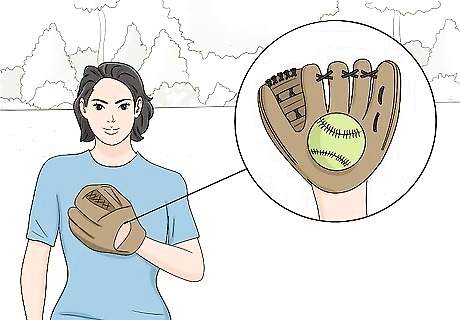
Hold the ball in the pocket of your glove at your chest. Once you’ve gotten into the correct pitching stance, grip the ball with your throwing arm and place it into the palm of the glove. Then, bend your arms so that you’re holding the ball and glove right in the center of your chest. Keep the ball in the glove until you’re ready to start going through the pitching motions. Make sure that you maintain good posture by keeping your shoulders pulled back but relaxed. Keeping your shoulders back will help you maintain focus and control, while staying relaxed will avoid building tension in your muscles that can lead to injury.
Perfecting Your Pitching Motion
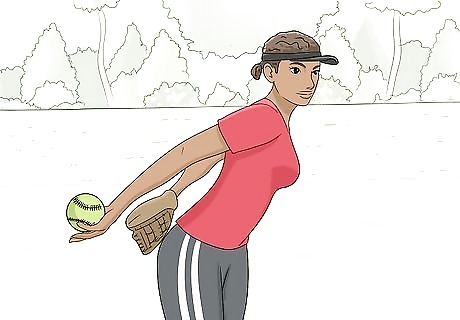
Start your pitch by moving your body forward. In fast-pitch softball, when you start moving your body forward in any capacity after you’ve touched the pitcher’s mound, this is considered the start of the pitch. You then have to move towards delivering the pitch for the pitch to be legal.
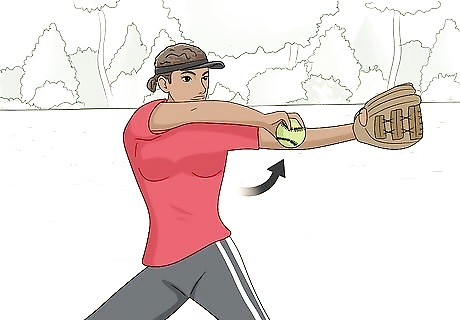
Reach your arms forward towards the catcher to build momentum. After rocking back on your heels, transfer your weight forward by reaching both your arms forward, pointing towards the catcher and home plate. This will help build even more momentum for your pitch. This is often referred to as a “superman” pose.
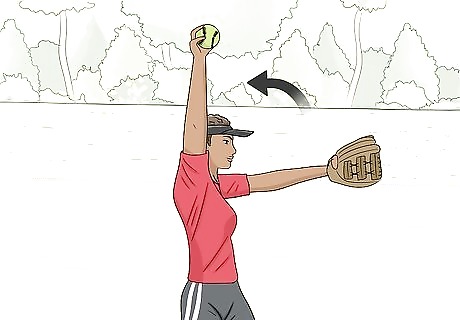
Swing your throwing arm up and into your backswing. To finish building momentum for your pitch, swing the arm with the ball back up over your head and down into your backswing. Keep your gloved hand forward to help guide your aim. As your arm swings up and back, your weight will naturally transfer to your back foot.
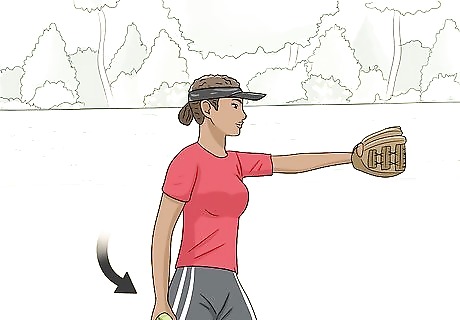
Shift your bodyweight forward as your swing to throw the ball. Right when your throwing arm hits the top of your backswing, swing your arm down past your hip and in front of your body to throw the ball towards the catcher. As your throwing arm swings forward, shift your bodyweight forward by pushing off with your back foot and stepping out in front of the plate. As your arm swings in front of your body, try to keep your shoulders as level and keep your head as still as possible. This will help you throw the ball faster and more accurately. Try to keep your body out of the way of your arm as you pitch.
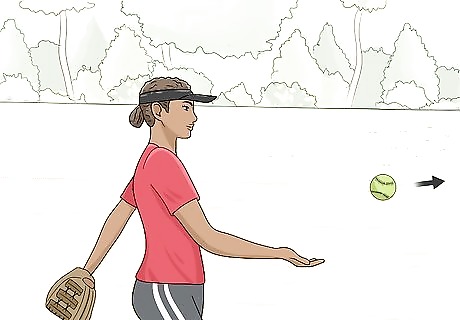
Release the ball as your throwing arm reaches in front of your body. As you swing your throwing arm forward, release the ball right when your hand passes by your hip. Your throwing arm will be pointing down at an angle with your palm facing out towards the catcher. If you release the ball too early, it will travel at an angle towards the ground near home plate. If you release it too late, it will likely go too high in the air. Therefore, it’s important that you practice to get a feel for the exact moment you need to release the ball to get it to travel straight to the catcher at the fastest possible speed. If you're trying to get a ball to go to the right, have your hand on the left side of the ball. If you're trying to throw a ball to the left, have your hand on the right side when you let go.
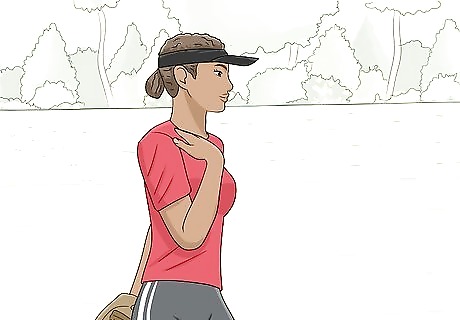
Let your arm follow through the forward swinging motion. After you release the ball, make sure the you let your arm follow through with the swing on its natural course. Your arm should continue to swing up to your chest. This will ensure that you let your arm gain the maximum amount of momentum and that you throw the softball with the maximum amount of speed. Following through with your swing will also help you avoid putting any extra strain on your muscles from an immediate, abrupt stop.
Practicing Your Pitch
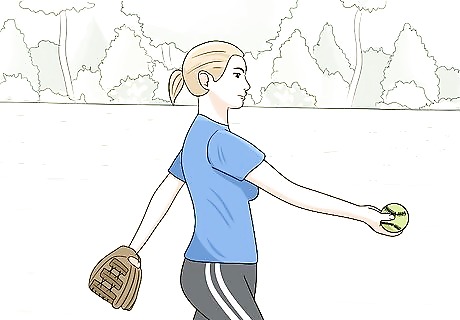
Warm up every time you practice pitching to avoid injury. Before pitching in fast-pitch softball practice or doing any drills on your own, warm up your body by slowly going through the motions of pitching. That way, your muscles will get warm and will remember the motion once you start to speed things up, which will help you avoid unnecessary injuries. When pitching in fast-pitch softball, you use more force than in soft pitch softball, which puts a lot of pressure on your muscles to perform. Therefore, it’s important that you warm up your muscles, particularly those in your arms and shoulders. Going for a quick jog or doing some jumping jacks is also a great way to warm up your whole body to avoid injury. If you don't want to practice for too long, try practicing more often. For example, you might practice your throws 6 days a week.
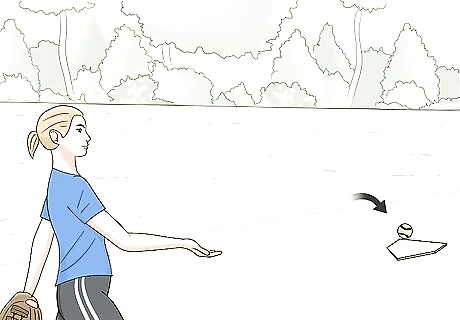
Increase and decrease your distance to practice your aim. To help you make sure the ball reaches home plate every time you pitch in a fast-pitch softball game, practice pitching at different distances and aiming for home plate each time. Start by throwing a few pitches from the pitching plate. Then, move back about 2 feet (0.61 m) after you pitch, staying at each distance until you can consistently pitch the ball fast and accurately to reach home plate. Once you get far enough away that you can’t reach home plate at all, start moving back towards the pitching plate. Once you get back to the pitching plate, the pitches should feel easy by comparison.
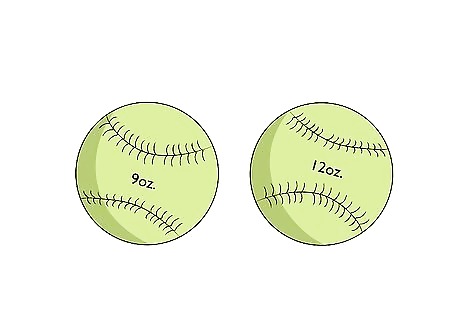
Practice with weighted softballs to increase your strength. Instead of using 6.25-ounce regulation softballs, try practicing with 9-, 10-, 11-, or 12-ounce weighted balls. This will help build up your arm strength, which will allow you to pitch regulation-weight balls faster and with ease. It’s particularly important that you warm up when using weighted balls, as the added weight puts extra pressure on your muscles and can cause injuries if you aren’t warmed up. Weighted softballs come in the same size as regulation-weight balls, so you can still practice with your 4-seam grip. Weighted softballs are available online and in most sporting goods stores and generally cost about $15 USD.
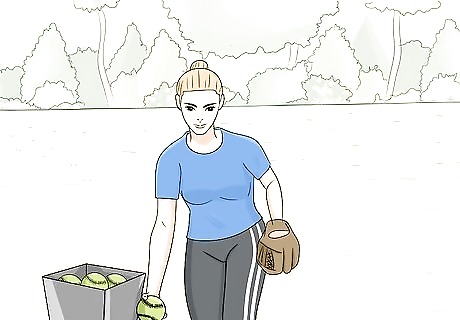
Do a speed-pitching drill to help speed up your pitching motion. First, make sure that your arms and shoulders are completely warmed up. Then, with several softballs on hand in a basket or pile next to you, go through about 15 pitches as quickly as you can. Your goal is to do all 15 pitches in less than 1 minute so that your body gets accustomed to the quick motion. While accuracy is always important when pitching in fast-pitch softball, for this drill, concentrate more on speed than distance or accuracy. Once you can do 15 pitches in under 1 minute consistently, make this drill more difficult by doing 15 speed pitches, resting for 1 minute, then pitching another 15 pitches in under 1 minute if you can.



















Comments
0 comment